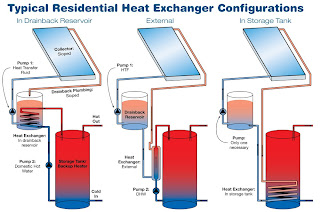As we’ve discussed before, pressurized
glycol and drain back solar heat systems are the two most common systems
designs used today. Today, we will discuss how a pressurized glycol system
works and how to care for one.
A pressurized glycol solar heat system has
a closed-loop design. Unlike with drain back systems, the water you use is not
passed through the collectors. A glycol and water mixture circulates through
the collectors, and your hot water is warmed by heat transfer from this
mixture. The glycol acts as antifreeze to prevent system components from
freezing. The concentration of glycol in the system is determined carefully in
order to provide adequate freeze protection for your solar heat system.
The pH of the glycol solution within your
system should be checked annually. Your solution needs replaced whenever the pH
falls below 7. Other components need checked regularly to ensure your solar
heat system is working properly. Pressure relief valves, check valves, and
automatic air vents are prone to failures and have short service lifespans.
These components should be tested as part of your solar heat system’s regular
maintenance routine to determine whether or not replacement is necessary.
Pressurized glycol systems require fluid
changing every few years. As these fluids are under pressure, it’s best to
contact a trained professional to perform this maintenance for you. Over time,
glycols within your system can degrade and cause system components to
deteriorate, which is one reason proper care for your pressurized glycol system
is important.
Solar heat systems are becoming more common
and are being utilized by more and more home and business owners every day.
Pressurized glycol systems can be a useful design for your application, but
require regular maintenance and care to maximize system life. If you have
questions about pressurized glycol solar heat systems, please give us a call.
At Smith Sustainable Design, we’re here to answer your solar heat questions
anytime.




